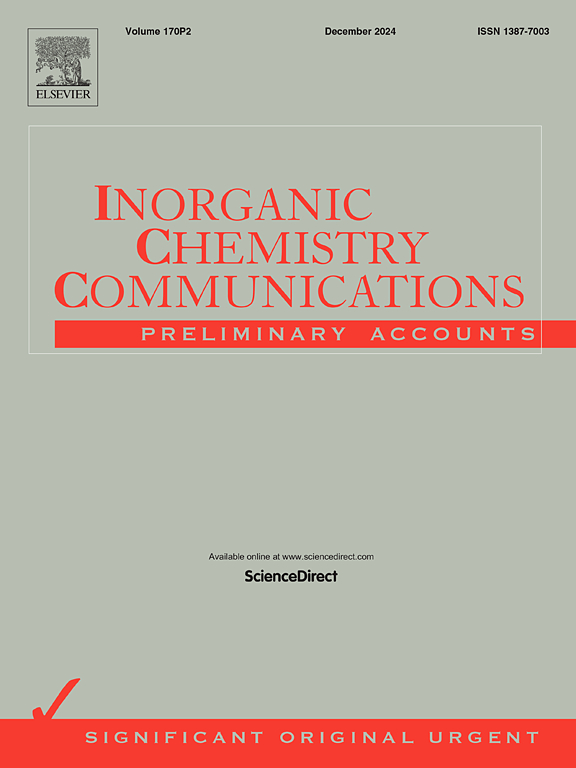Study on preparation, photocatalytic performance and degradation mechanism of Bi2WO6/Bi2S3/g-C3N4 composite
IF 4.4
3区 化学
Q1 CHEMISTRY, INORGANIC & NUCLEAR
引用次数: 0
Abstract
A new lotus-like Bi2WO6/Bi2S3/g-C3N4 composite was synthesized through hydrothermal reaction and physical doping techniques. And the degradation of norfloxacin (NFX) using Bi2WO6/Bi2S3/g-C3N4 (BiSW-GCN) photocatalytic material was investigated. Scanning electron microscopy (SEM) revealed that spherical Bi2S3 and flake-like g-C3N4 were closely adhered to the petals of Bi2WO6, with a uniform distribution of various elements observed in the Raman spectra. These spectra also indicated a reduction in fluorescence intensity and the recombination rate of photogenerated electron-hole pairs. Through analysis of the degradation efficiency of NFX with varying ratios of the photocatalytic materials, it was determined that the optimal photocatalytic performance was achieved when Bi2S3 constituted 3 % of the Bi2WO6 content, and the Bi2WO6/Bi2S3 to g-C3N4 ratio was set at 20:1. The influence of pH value, photocatalyst concentration, and NFX concentration on the degradation rate within the reaction environment was examined. Results showed that the material exhibited its highest efficiency in a neutral environment. With the addition of 1 g/L BiSW-GCN, the degradation rate of an 8 mg/L NFX solution reached 92.4 % within 120 min, and the total organic carbon (TOC) removal rate achieved 41.1 %. The kinetic constant for BiSW-GCN was calculated to be 0.0206 min−1. A trapping experiment demonstrated that the primary toxicity of the photocatalytic process was due to hole action, followed by photoelectron generation. Based on the inhibitory effect of NFX on E. coli, the toxicity of the degraded NFX solution was found to be absent when analyzed using the product intermediate toxicity assessment method, thus confirming the potential for the by-product to be non-toxic.

Bi2WO6/Bi2S3/g-C3N4复合材料的制备、光催化性能及降解机理研究
通过水热反应和物理掺杂技术合成了一种新型的荷叶状Bi2WO6/Bi2S3/g-C3N4复合材料。研究了Bi2WO6/Bi2S3/g-C3N4 (BiSW-GCN)光催化材料对诺氟沙星(NFX)的降解作用。扫描电镜(SEM)显示,球形Bi2S3和片状g-C3N4紧密粘附在Bi2WO6的花瓣上,拉曼光谱中各种元素分布均匀。这些光谱还表明荧光强度和光生电子-空穴对的复合速率降低。通过分析不同光催化材料配比对NFX的降解效率,确定当Bi2S3占Bi2WO6含量的3%,Bi2WO6/Bi2S3与g-C3N4的比例为20:1时,光催化性能最佳。考察了pH值、光催化剂浓度和NFX浓度对反应环境中降解率的影响。结果表明,该材料在中性环境下效率最高。当添加1 g/L BiSW-GCN时,8 mg/L的NFX溶液在120 min内降解率达到92.4%,总有机碳(TOC)去除率达到41.1%。计算出BiSW-GCN的动力学常数为0.0206 min−1。捕获实验表明,光催化过程的主要毒性是空穴作用,其次是光电子的产生。基于NFX对大肠杆菌的抑制作用,采用产物中间毒性评价方法分析,发现降解后的NFX溶液不存在毒性,从而确定了副产物无毒的可能性。
本文章由计算机程序翻译,如有差异,请以英文原文为准。
求助全文
约1分钟内获得全文
求助全文
来源期刊

Inorganic Chemistry Communications
化学-无机化学与核化学
CiteScore
5.50
自引率
7.90%
发文量
1013
审稿时长
53 days
期刊介绍:
Launched in January 1998, Inorganic Chemistry Communications is an international journal dedicated to the rapid publication of short communications in the major areas of inorganic, organometallic and supramolecular chemistry. Topics include synthetic and reaction chemistry, kinetics and mechanisms of reactions, bioinorganic chemistry, photochemistry and the use of metal and organometallic compounds in stoichiometric and catalytic synthesis or organic compounds.
 求助内容:
求助内容: 应助结果提醒方式:
应助结果提醒方式:


